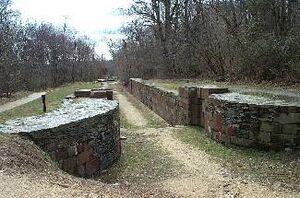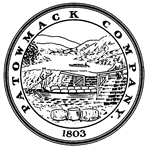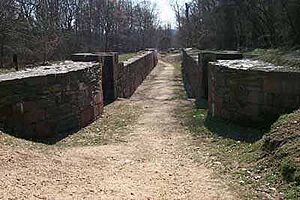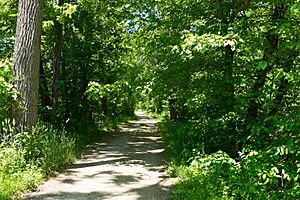Patowmack Canal facts for kids
|
Potomac Canal Historic District
|
|
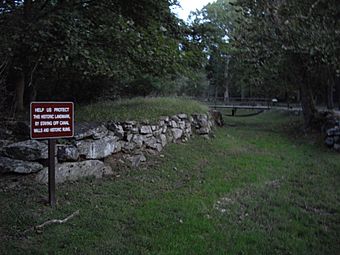 |
|
| Location | Fairfax County, Virginia, USA |
|---|---|
| Nearest city | Great Falls, Virginia |
| Area | 25 acres (10 ha) |
| Built | 1786 |
| Architect | Multiple |
| NRHP reference No. | 79003038 |
Quick facts for kids Significant dates |
|
| Added to NRHP | October 18, 1979 |
| Designated NHLD | December 17, 1982 |
The Patowmack Canal is a group of five old canals. They are located in Maryland and Virginia, United States. These canals were built to help boats get around fast-moving water (rapids) in the Potomac River. This area is upstream from where Washington, D.C. is today. The most famous part of the canal is near Great Falls, Virginia. Its remains are now part of Great Falls Park, which is managed by the National Park Service.
The Story of the Patowmack Canal
George Washington's Big Idea
One of George Washington's biggest dreams was to make the Potomac River easy to travel on. He wanted boats to be able to go all the way to the Ohio River Valley. After the American Revolutionary War, Washington believed that better ways to transport goods would connect the lands west of the Allegheny Mountains to the United States. He thought this would "bind those people to us by a chain which never can be broken."
Washington wrote that the best way was to "open a wide door" for goods from the West to reach markets. The Potomac River could be that "door." It was the shortest path between the Tidelands (where boats could reach the East Coast and across the Atlantic Ocean) and the start of the Ohio River (which led to the western frontier). But there were political and physical problems to solve.
To open the Potomac, Virginia and Maryland had to work together. Both states bordered the river. In 1784, Washington convinced the states to create a company. This company would improve the Potomac River from its start near Cumberland, Maryland, to the tidewater at Georgetown.
The Patowmack Company was formed on May 17, 1785. Its leaders and investors came from both states. Washington wrote in his diary that he became the company's president. He led the project until he became the first President of the United States.
In 1785, leaders from Virginia and Maryland met at Washington's home. They created the Mount Vernon Compact, which allowed free trade on the river. Virginia and Maryland then invited all 13 states to a meeting in Annapolis in 1786. This meeting was to discuss how to create fair trade rules for everyone. The Annapolis Convention helped lead to the Constitutional Convention in Philadelphia in 1787. So, George Washington's work on the Potomac River helped set the stage for the creation of the U.S. Constitution!
Building the Canals: Overcoming Nature's Challenges
The Potomac River had many natural obstacles. It was narrow and winding in some places. It also dropped over 600 feet in 200 miles from Cumberland to sea level. Spring rains made the river dangerously high. Summer droughts made it too shallow for boats. To make the river usable, the Patowmack Company had to dig parts of the riverbed. They also had to build canals to go around five areas of fast-moving water (falls).
Five canals were built:
- Little Falls
- Great Falls
- Seneca Falls (across from Seneca Creek)
- Payne's Falls of the Shenandoah
- House Falls (near Harpers Ferry)
Three of these canals (Seneca Falls, House Falls, and Payne's Falls) did not need special water gates called locks. Little Falls used wooden locks, which were not meant to last forever.
The Little Falls Canal
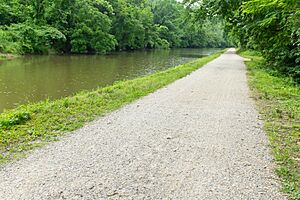
The Little Falls canal was on the Maryland side of the river. It was about 3,814 yards long. The first locks, near today's Fletcher's Cove, were made of wood and finished in 1795. These wooden locks were replaced with stone locks in 1817. They helped boats move up or down 37 feet. The first two locks were named "Martha" and "George," after Martha and George Washington.
This canal was later used for the Chesapeake and Ohio Canal (C&O). Parts of it became Feeder #1 and the canal itself. The stone locks were destroyed around 1910 when the Baltimore and Ohio Railroad (B&O) built its Georgetown Branch line. This old rail line is now the Capital Crescent Trail.
The Great Falls Canal
Building the canal and locks around the Great Falls of the Potomac River was the hardest job. Here, the river drops almost 80 feet in less than a mile. Strong currents, solid rock, and constant money and worker problems slowed down progress.
Construction started in 1785 and took 17 years to finish. This was six years longer than it took to plan and build the new federal city of Washington, D.C., which was ten miles downriver. Building the canal needed special engineering skills and many workers. These were hard to find in the 1700s in America. Workers included unskilled laborers, skilled workers who had signed contracts, and enslaved people rented from nearby farms. The work was tough and dangerous. Workers used black powder (an early form of explosive) to blast a path through the rock cliffs for the last three locks.
The Great Falls canal is 1,820 yards long. It was finished in 1801 and opened for boats in 1802. Its five locks helped boats go around Great Falls. The locks were built from red sandstone from the Seneca Quarry in Maryland. It took about an hour to move a boat through all the locks.
A whole town called Matildaville grew up around the construction site. It was the main office for the Patowmack Company and home for the workers. Light Horse Harry Lee, a hero from the Revolutionary War, founded the town. He was the father of Robert E. Lee and named the town after his first wife, Matilda Lee.
The Seneca Falls Canal
This canal was 1,320 yards long. Even though the river dropped 7 feet here, this canal on the Virginia side did not need locks. Work on it began in 1785. It is across from Seneca Creek, Maryland.
The Shenandoah or Paynes Falls Canal
This canal was just below Harpers Ferry. It was 1,760 yards long and dropped 15 feet, but it also had no locks. Some boatmen called it the Bullring Canal. It was made of two short canals with a "short sheet of water" between them.
The House Falls Canal
This Maryland canal was also called the Long Canal. It had no locks and helped boats get past a three-foot drop. This canal was later used for the C&O Canal for almost a mile.
Other River Improvements
The Patowmack Company also worked on other rivers that flowed into the Potomac. These included Conococheague Creek, the Monocacy River, Patterson Creek, South Branch, Cacpon Creek, Opequon Creek, and the Shenandoah River.
Life and Trade on the Canal
At its busiest, Matildaville had the company leader's house, a market, a grist mill (for grinding grain), a sawmill, a metal foundry, an inn, an ice house, and homes for workers. Boaters would stop here to wait their turn through the locks, change their cargo, or enjoy the town before continuing their trip.
Thousands of boats used the locks at Great Falls. They carried goods like flour, whiskey, tobacco, and iron downstream. They brought cloth, hardware, firearms, and other products upstream. Boats ranged from simple rafts to long, narrow "sharpers." A sharper was a keelboat that could carry up to 20 tons of cargo.
A trip downstream to Georgetown took 3 to 5 days. Going back upstream to Cumberland, pushing against the current, took 10 to 12 days. Many boat owners simply sold their boats for scrap and walked back home instead.
Here is what was carried down the canal in 1811:
| Item | Qty |
|---|---|
| Sugar | 27 hogsheads |
| Flour | 118,076 barrels |
| Whiskey | 5718 barrels |
| Wheat | 465 bushels |
| Corn | 3600 bushels |
Other items carried in 1811 included firearms, pig iron, timber, rye, flax seed, hemp, butter, oats, cloverseed, and staves (wooden strips for barrels).
Gondolas were large, one-time-use rafts made of logs. They were about 60 feet long and 10 feet wide and could hold many tons of cargo. Sharpers were flat-bottomed boats, 60 feet long and 7 feet wide. These were also pushed down the river. However, they could only get through the shallow parts of the Potomac about 45 days a year, during spring floods. It was common for boats to crash and lose their cargo. People in a nearby settlement called Cooney often found coal, flour, and meat from these wrecks.
The canal was supposed to be open all year. But it only operated seasonally, from February to May. Summer droughts would close it until the autumn rains returned.
Matildaville's future was linked to the Patowmack Company. Today, only a few small remains of Matildaville can be seen.
The biggest problem for the Patowmack project was money. The cost of building, especially at Great Falls, was very high. The company did not earn enough money from tolls to cover its costs. Extreme high and low water levels meant the canal could only be used for a month or two each year. The tolls collected could not even pay the interest on the company's debt.
The company tried to make more improvements on other parts of the Potomac. But this did not bring in more money. They sold more shares, borrowed from banks, and even tried a lottery. Nothing worked.
The End of Canal Operations
The Erie Canal opened in 1825. It quickly became a competitor, connecting the Great Lakes to the Eastern Seaboard. The Patowmack Company went out of business in 1828. It handed over its property and debts to the new C&O Canal Company.
The new company stopped using the Patowmack Canal (except for the part at Little Falls) in 1830. They had a bigger plan: a man-made waterway from Georgetown to Pittsburgh. Even though the Patowmack Company failed financially, its builders were pioneers in lock engineering. They inspired many other canal projects that were important for the country's growth.
The C&O Canal began construction near Lock 6, close to the Little Falls Skirting Canal. The Little Falls canal was changed and used for the C&O Canal. It also became its feeder canal (Inlet #1).
The Shenandoah canal was still used sometimes. This is why the C&O Canal had to build the Shenandoah River lock (just below Lock 33) at Harper's Ferry. This helped them get permission from the Virginia state government. Boats would leave the C&O Canal, and their mules would cross the B&O railroad bridge. Then, the boats would go through the Shenandoah canal.
George Washington did not live to see the canal project finished. But he was proud to visit the canal during construction to check on its progress. He died in 1799, two years before the canal opened at Great Falls. In the long run, Washington's dream of a strong nation connected by trade came true. His frequent toast, "Success to the navigation of the Potomac!" became a small but important part of American history.
Current Recreational Use and Visiting the Canal
Protecting a Historic Site
In 1930, the U.S. Congress made this historic and beautiful place a park. The National Park Service took over managing it in 1966.
Protecting the Patowmack Canal is part of the Park Service's ongoing work. The Patowmack Canal and the ruins of Matildaville are protected by the Archaeological Resources Protection Act of 1979. This law makes it illegal to dig up, remove, or move old historical items. The Patowmack Canal is very important to the development of the young United States. It has been named a National Historic Landmark, a National Historic Civil Engineering Landmark, and a Virginia Historic Landmark.
The remains of the Seneca canal can still be seen on the Virginia side. It is across from Violette's lock on the C&O Canal.
Visiting Great Falls Park Safely
Great Falls Park is open to the public every day, and there is an admission fee.
Safety is very important in the Park. Some activities are not allowed, such as alcohol, open fires, swimming, wading, or crossing any open water. Dangerous activities like rock climbing and kayaking at Great Falls Park should only be done by experienced people. These people must know the dangers and safety rules. This area can be dangerous, and accidental deaths have happened. The park had 27 deaths between 2001 and 2013.
The Patowmack Canal Trail is accessible for wheelchairs as far as Lock 1. The trail surface is packed dirt with no curbs. The National Park Service opened a wheelchair-friendly viewpoint of the Great Falls in January 2005. They were also working on a second viewpoint, which was expected to be finished in May 2005.
The Great Falls part of the canal, along with the old ruins of Matildaville and other nearby canal sites, was named a National Historic Landmark in 1982. It is recognized as one of the nation's first big civil engineering projects. It shows the ideas of two of America's Founding Fathers, George Washington and James Madison.


